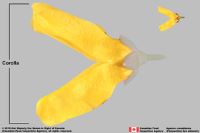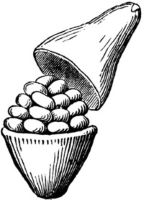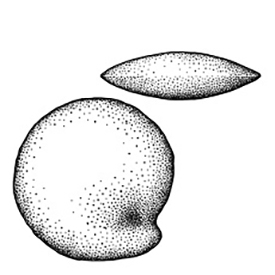Content is from Kirkbride et al. 2006Kirkbride et al. 2006:
Kirkbride JH, Jr, Gunn CR, and Dallwitz MJ. 2006. Family guide for fruits and seeds, vers. 1.0. Accessed September 2020-January 2022. URL: https://nt.ars-grin.gov/seedsfruits/keys/frsdfam/index.cfm ., without modification.
Updates are forthcoming.
Fruits: Pistil(s) compound; 1; 1-pistillate; with carpels united. Fruit pericarpium; simple; capsulecapsule:
a dry, dehiscent fruit derived from a compound ovary ; pyxidium capsulecapsule:
; pyxidium capsulecapsule:
a dry, dehiscent fruit derived from a compound ovary ; capsulecapsule:
; capsulecapsule:
a dry, dehiscent fruit derived from a compound ovary not inflated; capsulecapsule:
not inflated; capsulecapsule:
a dry, dehiscent fruit derived from a compound ovary without operculumoperculum:
without operculumoperculum:
a dehiscent cap (or lid) of a seed or fruit that opens during germination or dehiscence ; without persistent central column; not within accessory organ(s), or within accessory organ(s) (See Airy Shaw); within calyxcalyx:
; without persistent central column; not within accessory organ(s), or within accessory organ(s) (See Airy Shaw); within calyxcalyx:
the outer whorl of the perianth; all the sepals of a flower and corollacorolla:
and corollacorolla:
the inner whorl(s) of the perianth; all the petals of a flower ; 10 to less than 25-seeded to 25 to less than 50-seeded; 12–28-seeded; less than 1 cm long; 0.3–0.4 cm long (in diameter); with 5–16-carpellate; with carpels united; with carpels remaining united at maturity; with carpels not radiating at maturity; without sterilesterile:
; 10 to less than 25-seeded to 25 to less than 50-seeded; 12–28-seeded; less than 1 cm long; 0.3–0.4 cm long (in diameter); with 5–16-carpellate; with carpels united; with carpels remaining united at maturity; with carpels not radiating at maturity; without sterilesterile:
lacking male and/or female reproductive parts; also, not producing fruit or seed
 carpels; sulcatesulcate:
carpels; sulcatesulcate:
surface relief—having one or more elongate, relatively narrow and shallow depressions or grooves ; in transection tereteterete:
; in transection tereteterete:
approximately circular in cross section; width and thickness approximately equal
 ; apexapex:
; apexapex:
the point farthest from the point of attachment, or the "tip" of an organ not beaked; wall fleshy (drying upon maturing); dehiscentdehiscent:
not beaked; wall fleshy (drying upon maturing); dehiscentdehiscent:
(v. dehisce) splitting open at maturity to release contents (of a fruit) . Dehiscentdehiscent:
. Dehiscentdehiscent:
(v. dehisce) splitting open at maturity to release contents (of a fruit) unit endocarp(s). Dehiscentdehiscent:
unit endocarp(s). Dehiscentdehiscent:
(v. dehisce) splitting open at maturity to release contents (of a fruit) regularly, or irregularly (to somewhat); passively; linearly; by circumscissilecircumscissile:
regularly, or irregularly (to somewhat); passively; linearly; by circumscissilecircumscissile:
(~pyxis); type of capsular dehiscence, opens by a lid (splitting transversely) slit; at middle; and shedding seeds; without replumreplum:
slit; at middle; and shedding seeds; without replumreplum:
the rim, formed by the persistent placentas, and connected by a false septum in Brassicaceae fruits. The fruit valves are attached to this rim and separate from it in dehiscent fruits.
. Epicarpepicarp:
outer layer of fruit wall or pericarp, if divided into layers; note here used synonymously with exocarp dulldull:
dulldull:
reflecting only a low proportion of incident light, with no apparent sheen (assumed); durable; glabrousglabrous:
(assumed); durable; glabrousglabrous:
without hairs
; without armature; without wing(s); without apicalapical:
at or pertaining to the end of the seed or fruit distal from its point of attachment (i.e., base)
respiratory hole. Mesocarpmesocarp:
the middle layer of the pericarp, if divided into layers absent. Endocarpendocarp:
absent. Endocarpendocarp:
the inner layer of the pericarp, if divided into layers present; not separating from exocarpexocarp:
present; not separating from exocarpexocarp:
outer layer of fruit wall or pericarp, if divided into layers; note here used synonymously with epicarp ; thin; not splitting into 1-seeded pyrenes; smooth; without wing; without operculumoperculum:
; thin; not splitting into 1-seeded pyrenes; smooth; without wing; without operculumoperculum:
a dehiscent cap (or lid) of a seed or fruit that opens during germination or dehiscence ; without secretory cavities; without mechanism for seedling escape; without grooves; without longitudinallongitudinal:
; without secretory cavities; without mechanism for seedling escape; without grooves; without longitudinallongitudinal:
of or relating to length or the lengthwise dimension
ridges. Funiculusfuniculus:
(alt. funicle) stalk connecting the ovule (later seed) to the ovary (later fruit) placenta short; short without seed bearing hookswith hooks:
short; short without seed bearing hookswith hooks:
bristles or spines with curved or backwards pointing tips, or with secondary bristles along their length (retinacula); not persisting in fruit after seed shed.
(retinacula); not persisting in fruit after seed shed.
Seeds: Arilaril:
(broad sense) appendicular structure that wholly or partly envelops a seed and is produced from or a modification of the funicle, raphe, or outer integument; usually fleshy or pulpy, sometimes spongy or tufted-capillate, often brightly colored absent. Seed larger than minute, or minute; less than 1 mm long to 1 to less than 5 mm long; 0.5–1 mm long; reniformreniform:
absent. Seed larger than minute, or minute; less than 1 mm long to 1 to less than 5 mm long; 0.5–1 mm long; reniformreniform:
2D or 3D shape—kidney-shaped (slightly), or ovateovate:
(slightly), or ovateovate:
2D shape—egg-shaped in outline, widest point is towards one end of the organ, the other end tapers gradually, attachment at or near the broad end (compare obovate, ovoid) ; in transection compressedcompressed:
; in transection compressedcompressed:
flattened; in grasses, used to denote compression (not necessarily flattened) either laterally or dorsiventrally
; not bowl shaped; not nutlike; without winglike beakbeak:
a usually firm, terminal appendage, sometimes tapered ; without caudatecaudate:
; without caudatecaudate:
tapering to a long, tail-like appendage appendage(s); at maturity with food reserves; with endosperm; without canavanine. Sarcotestasarcotesta:
appendage(s); at maturity with food reserves; with endosperm; without canavanine. Sarcotestasarcotesta:
pulpy or fleshy outer layer of the seed coat, simulates aril absent. Testatesta:
absent. Testatesta:
seed coat
 present; without markedly different marginalmarginal:
present; without markedly different marginalmarginal:
at, on, or close to the margin or border
tissue; without fleshy or leatheryleathery:
texture—moderately thick, tough, and very pliable
layer over hard layer; tight; dulldull:
reflecting only a low proportion of incident light, with no apparent sheen ; surface unsmooth; surface with depressed features, or discreet raised features, or merged raised features; surface punctatepunctate:
; surface unsmooth; surface with depressed features, or discreet raised features, or merged raised features; surface punctatepunctate:
surface relief—dotted with pits or with translucent, sunken glands or with colored dots, similar to pitted ; surface papillatepapillate:
; surface papillatepapillate:
surface relief—bearing minute, distinct, broad-based projections, tapering to a rounded apex (Pholisma); surface reticulatereticulate:
(Pholisma); surface reticulatereticulate:
surface relief—netted, raised walls or concave grooves forming a net-like surface pattern with flat, concave, or convex interspaces , or roughenedroughened:
, or roughenedroughened:
texture—having a small, stout, stiff, more or less acute protrusions
; without crease or line separating cotyledons from hypocotyl-radicle; without notch along margin where cotyledons from hypocotyl-radicle tip approach each other; without glands; without bristles; glabrousglabrous:
without hairs
; without wings; without collar; without operculumoperculum:
a dehiscent cap (or lid) of a seed or fruit that opens during germination or dehiscence ; colored; monochrome; brown (all shades); not becoming mucilaginousmucilaginous:
; colored; monochrome; brown (all shades); not becoming mucilaginousmucilaginous:
resembling mucilage; moist and sticky
when wetted; surrounding food reserve. Endosperm development cellular; copious; smooth; with starch; without fatty acid containing cyclopropene; without apicalapical:
at or pertaining to the end of the seed or fruit distal from its point of attachment (i.e., base)
lobes; without chlorophyll; without isodiametric faceted surface; without odor. Embryo differentiated from food reserve; rudimentaryrudimentary:
(of embryo) embryo is small and fills less than a quarter of the seed and can be variable in shapes, such as linear, spatulate, or oval ; 1 per seed; partially filling testatesta:
; 1 per seed; partially filling testatesta:
seed coat
 (with food reserve); at one end of seed not extending into a depression or cup; lenticularlenticular:
(with food reserve); at one end of seed not extending into a depression or cup; lenticularlenticular:
3D shape—lens-shaped; biconvex , or globoseglobose:
, or globoseglobose:
3D shape—more or less spherical ; parallel to seed length; without coleorhiza; without simmondsin; without stomata; not green; acotyledonous. Hypocotyl-radicle undeveloped.
; parallel to seed length; without coleorhiza; without simmondsin; without stomata; not green; acotyledonous. Hypocotyl-radicle undeveloped.
 enclosed by persistent calyxcalyx:
enclosed by persistent calyxcalyx: or corollacorolla:
or corollacorolla: that dehisces 1-seeded stones enclosed by persistent calyxcalyx:
that dehisces 1-seeded stones enclosed by persistent calyxcalyx: and corollacorolla:
and corollacorolla: . Yatskievych (1986): "Fruit slightly depressed capsulecapsule:
. Yatskievych (1986): "Fruit slightly depressed capsulecapsule: , somewhat fleshy, but drying at maturity; dehiscentdehiscent:
, somewhat fleshy, but drying at maturity; dehiscentdehiscent: circumscisslely by an irregular ring below middle of capsulecapsule:
circumscisslely by an irregular ring below middle of capsulecapsule: (fig. 10)" - like Portulacca.
(fig. 10)" - like Portulacca.
Literature specific to this family: Yatskievych, G. & C.T. Mason, Jr. 1986. A revision of the Lennoaceae. Syst. Bot. 11:531–548; Thackery, F.A. & M.F. Gilman. 1930. A rare parasitic food plant of the Southwest. Rep. (Annual) Board Regents Smithsonian Inst. 1930:409–416 + 9 plates; Yatskievych, G. 1985. Notes of the biology of the Lennoaceae. Cact. Succ. J. (Los Angeles) 57:73–79; Dressler, R.L. & J. Kuijt. 1968. A second species of Ammobroma (Lennoaceae) in Sinaloa, Mexico. Madroña 19:179–182.
General references: Airy Shaw, H.K. 1973. A dictionary of the flowering plants and ferns, 1,131 pp. University Press, Cambridge, Cronquist, A. 1981. An integrated system of classification of flowering plants, 1,262 p. Columbia University Press, New York, Goldberg, A. 1986 (dicots) & 1989 (monocots). Classification, evolution, and phylogeny of the familes of Dicotyledons. Smithsonian Contr. Bot. 58 for dicots (314 pp.) & 71 for monocots (74 pp.). [Goldberg's illustrations are reproduced from older publications and these should be consulted], Gunn, C.R., J.H. Wiersema, C.A. Ritchie, & J.H. Kirkbride, Jr. 1992 & amendments. Families and genera of Spermatophytes recognized by the Agricultural Research Service. Techn. Bull. U.S.D.A. 1796:1–500, and Spjut, R.W. 1994. A systematic treatment of fruit types. Mem. New York Bot. Gard. 70:1–182.